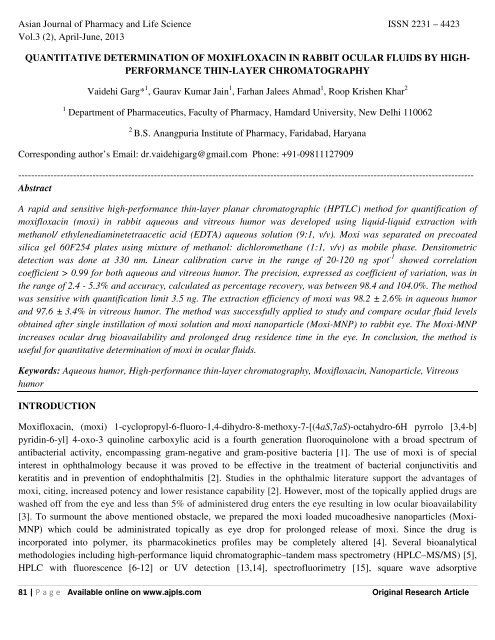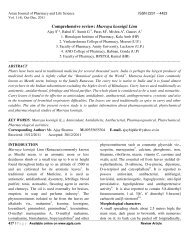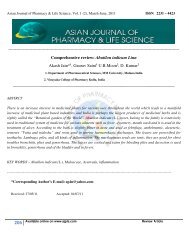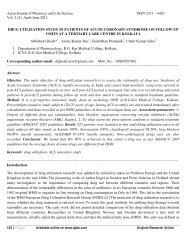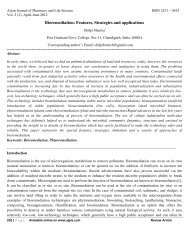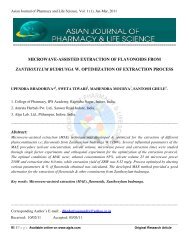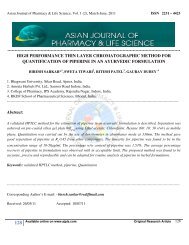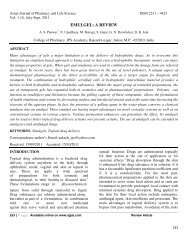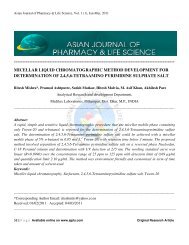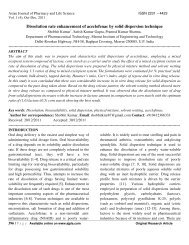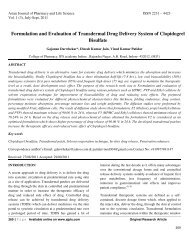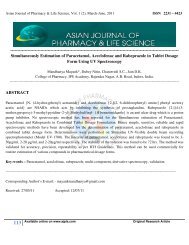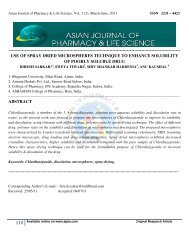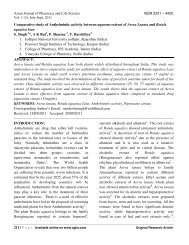(2), April-June, 2013 QUANTITATIVE DETERMINATION OF MOXI
(2), April-June, 2013 QUANTITATIVE DETERMINATION OF MOXI
(2), April-June, 2013 QUANTITATIVE DETERMINATION OF MOXI
Create successful ePaper yourself
Turn your PDF publications into a flip-book with our unique Google optimized e-Paper software.
Asian Journal of Pharmacy and Life Science ISSN 2231 – 4423<br />
Vol.3 (2), <strong>April</strong>-<strong>June</strong>, <strong>2013</strong><br />
<strong>QUANTITATIVE</strong> <strong>DETERMINATION</strong> <strong>OF</strong> <strong>MOXI</strong>FLOXACIN IN RABBIT OCULAR FLUIDS BY HIGH-<br />
PERFORMANCE THIN-LAYER CHROMATOGRAPHY<br />
Vaidehi Garg* 1 , Gaurav Kumar Jain 1 , Farhan Jalees Ahmad 1 , Roop Krishen Khar 2<br />
1 Department of Pharmaceutics, Faculty of Pharmacy, Hamdard University, New Delhi 110062<br />
2<br />
B.S. Anangpuria Institute of Pharmacy, Faridabad, Haryana<br />
Corresponding author’s Email: dr.vaidehigarg@gmail.com Phone: +91-09811127909<br />
---------------------------------------------------------------------------------------------------------------------------------------------<br />
Abstract<br />
A rapid and sensitive high-performance thin-layer planar chromatographic (HPTLC) method for quantification of<br />
moxifloxacin (moxi) in rabbit aqueous and vitreous humor was developed using liquid-liquid extraction with<br />
methanol/ ethylenediaminetetraacetic acid (EDTA) aqueous solution (9:1, v/v). Moxi was separated on precoated<br />
silica gel 60F254 plates using mixture of methanol: dichloromethane (1:1, v/v) as mobile phase. Densitometric<br />
detection was done at 330 nm. Linear calibration curve in the range of 20-120 ng spot -1 showed correlation<br />
coefficient > 0.99 for both aqueous and vitreous humor. The precision, expressed as coefficient of variation, was in<br />
the range of 2.4 - 5.3% and accuracy, calculated as percentage recovery, was between 98.4 and 104.0%. The method<br />
was sensitive with quantification limit 3.5 ng. The extraction efficiency of moxi was 98.2 ± 2.6% in aqueous humor<br />
and 97.6 ± 3.4% in vitreous humor. The method was successfully applied to study and compare ocular fluid levels<br />
obtained after single instillation of moxi solution and moxi nanoparticle (Moxi-MNP) to rabbit eye. The Moxi-MNP<br />
increases ocular drug bioavailability and prolonged drug residence time in the eye. In conclusion, the method is<br />
useful for quantitative determination of moxi in ocular fluids.<br />
Keywords: Aqueous humor, High-performance thin-layer chromatography, Moxifloxacin, Nanoparticle, Vitreous<br />
humor<br />
INTRODUCTION<br />
Moxifloxacin, (moxi) 1-cyclopropyl-6-fluoro-1,4-dihydro-8-methoxy-7-[(4aS,7aS)-octahydro-6H pyrrolo [3,4-b]<br />
pyridin-6-yl] 4-oxo-3 quinoline carboxylic acid is a fourth generation fluoroquinolone with a broad spectrum of<br />
antibacterial activity, encompassing gram-negative and gram-positive bacteria [1]. The use of moxi is of special<br />
interest in ophthalmology because it was proved to be effective in the treatment of bacterial conjunctivitis and<br />
keratitis and in prevention of endophthalmitis [2]. Studies in the ophthalmic literature support the advantages of<br />
moxi, citing, increased potency and lower resistance capability [2]. However, most of the topically applied drugs are<br />
washed off from the eye and less than 5% of administered drug enters the eye resulting in low ocular bioavailability<br />
[3]. To surmount the above mentioned obstacle, we prepared the moxi loaded mucoadhesive nanoparticles (Moxi-<br />
MNP) which could be administrated topically as eye drop for prolonged release of moxi. Since the drug is<br />
incorporated into polymer, its pharmacokinetics profiles may be completely altered [4]. Several bioanalytical<br />
methodologies including high-performance liquid chromatographic–tandem mass spectrometry (HPLC–MS/MS) [5],<br />
HPLC with fluorescence [6-12] or UV detection [13,14], spectrofluorimetry [15], square wave adsorptive<br />
81 | P a g e Available online on www.ajpls.com Original Research Article
Asian Journal of Pharmacy and Life Science ISSN 2231 – 4423<br />
Vol.3 (2), <strong>April</strong>-<strong>June</strong>, <strong>2013</strong><br />
voltammetry [16] and capillary electrophoresis [17] have been developed for the measurement of moxi, but are<br />
mainly restricted to plasma matrices. Recently, an HPLC method with fluorescence detection is described for the<br />
quantification moxi in aqueous and vitreous humor, but the method has high retention time (16.7 min) of moxi [18].<br />
Presence of metal ions such as Cu, Fe and Zn as a component of ocular fluids makes the analysis of moxi<br />
problematic, since chelation between metal ion and carbonyl and carboxyl groups of moxi is a common phenomenon<br />
resulting in drug binding and precipitation [19,20]. Under the stability indicating high-performance thin-layer<br />
chromatographic (HPTLC) condition for moxi, described previously by our group [21], the quantitation of moxi in<br />
ocular fluids is difficult leading to poor drug recovery and peak tailing effects. The present work comes up from the<br />
modification of the reported method with aim to develop a non-time consuming, simple and sensitive HPTLC method<br />
for determination of moxi in ocular fluids with a quantification limit sufficiently low to support pharmacokinetic<br />
studies. Several chelating agents (EDTA, citric acid, oxalic acid, sodium diethanol glycine) are tried to see their<br />
effects on drug recovery and peak symmetry. The proposed method is also applied to monitor ocular fluid<br />
pharmacokinetics following topical instillation of moxi solution and Moxi-MNP to rabbit eye.<br />
METHODS<br />
Chemical and Reagents<br />
Moxi was received as a gift sample from Ranbaxy Laboratories Ltd. (Gurgaon, Haryana, India) and certified to<br />
contain 99.62% (w/w) on dried basis. Medium molecular weight chitosan (CS) (with a deacetylation degree >80%)<br />
was received as a gift sample from India Sea Foods (India). Poly (lactide-co-glycolide) (PLGA, RES 503H) having a<br />
monomer ratio (lactic acid/glycolic acid) of 50:50 was purchased from Boheringer Ingheleim (Germany). All other<br />
chemicals and reagents used were of analytical grade and were purchased from Merck Ltd. (Worli, Mumbai, India).<br />
For validation of the method, aqueous humor and vitreous humor was obtained from the healthy rabbits. All samples<br />
were frozen at – 20°C until analysis.<br />
Chromatography<br />
Chromatography was performed as described previously [22,23]. Briefly, precoated silica gel on aluminium plates<br />
60F-254 (20 cm ×10 cm, 200µm thickness, E. Merck, Germany) were used after spraying with solution of 5% EDTA,<br />
pH adjusted to 9.0 with a 10% (m/v) NaOH solution. The plates were dried in a horizontal position for 30 min at<br />
110°C in an oven. The samples were spotted in the form of bands of width 5 mm with Camag 100 microlitre syringe<br />
using a Linomat V (Camag, Muttenz, Switzerland) sample applicator. The equipment parameters include constant<br />
application rate of 150 nL s −1 , slit dimension of 5 mm × 0.45 mm and scanning speed of 20 mm s −1 . The linear<br />
ascending development carried out in 20 cm ×10 cm twin through glass chamber (Camag, Muttenz, Switzerland)<br />
include band space of 10 mm, chamber saturation time of 30 min, chromatogram run of 8 cm and optimized at room<br />
temperature of 25±2°C and relative humidity of 60±5%. The mobile phase was methylene chloride: methanol (1:1,<br />
v/v) with densitometric analysis at 330 nm in the absorbance mode with Camag TLC scanner III operated by<br />
winCATS software (Version 1.2.0).<br />
Standard solutions and spiked samples<br />
Stock solution of moxi (1.2 mg mL -1 ) was prepared by dissolving 24 mg in 20 mL of methanol. Working solutions<br />
ranging from 0.2-1.2 mg mL -1 were prepared by properly diluting stock solution with methanol. One microliter of<br />
82 | P a g e Available online on www.ajpls.com Original Research Article
Asian Journal of Pharmacy and Life Science ISSN 2231 – 4423<br />
Vol.3 (2), <strong>April</strong>-<strong>June</strong>, <strong>2013</strong><br />
each working solution of moxi was used to spike aqueous and vitreous humor samples (10 µL) in order to obtain<br />
calibration standards ranging from 20-120 ng µL -1 . QC samples were prepared at concentration of 20 (low QC), 60<br />
(medium QC) and 120 (high QC) ng µL -1 . Each level was divided into aliquots of 10.0 µL and immediately frozen at<br />
–20°C.<br />
Ocular fluid sample preparation<br />
Prior to analysis, aqueous and vitreous humor was thawed at room temperature for about 10 minutes. Ten µL of<br />
aqueous and vitreous humor calibration standards and QC samples were transferred into vials and mixed with 1.0 mL<br />
of extracting solvent (mixture of methanol: aqueous solution of EDTA, 9:1). After vortex mixing for 1 minute, the<br />
samples were centrifuged (5 min, > 2000 g). The supernatant was transferred to new tubes and the solvent was<br />
evaporated at 37°C under nitrogen stream. The samples were reconstituted with 10 µL of methanol. One microliter of<br />
each sample was spotted on the TLC plate to obtain calibration range of 20-120 ng spot −1 .<br />
Preparation of Moxi-MNPs<br />
The nanoparticles were prepared by a modified coacervation method as reported by Calvo et al. [24]. Briefly, the<br />
solution of PLGA (4.0%, w/v) in acetone was sprayed into the CS solution (0.2%, w/v) containing moxi (0.4%, w/v)<br />
and polyvinyl alcohol (PVA), under continuous magnetic stirring at 2000 rpm for 1h. PVA (1.0% w/v) acted as a<br />
stabilizer and aid dispersion of nanoparticles. Nanoparticles were formed as a result of the interaction between<br />
negative charged carboxylic groups of PLGA and positively charged amino groups of CS. Nanoparticles were<br />
collected by centrifugation (REMI Corporation, India) at 18,000 rpm for 30 min at 4°C. The droplet size and zeta<br />
potential were measured using a Zetasizer Nano-ZS90 (Malvern, U.K.).<br />
Validation Procedures<br />
1. Selectivity<br />
The selectivity of the method was investigated by assessment of potential interferences from endogenous matrix<br />
constituents using the HPTLC conditions described above for monitoring moxi. All the samples were cleaned up as<br />
described in sample preparation section and the R f values of endogenous compounds in the matrix were compared<br />
with those of moxi.<br />
2. Detection and quantitation limits<br />
In order to estimate the detection limit (DL) and quantitation limit (QL), blank methanol was spotted six times<br />
following the same method as explained in section 2.2 and the standard deviation (σ) of the magnitude of analytical<br />
response was determined. The DL was expressed as 3.3σ/slope of moxi calibration curve, whereas QL was expressed<br />
as 10σ/slope of moxi calibration curve.<br />
3. Accuracy and precision<br />
The intra-day precision and accuracy of the assays was evaluated by performing replicate analyses (n=6) of QC<br />
samples (20, 60 and 120 ng spot −1 ) in ocular fluids. The inter-day precision and accuracy of the assay was determined<br />
by repeating the intra-day assay on three different days. Precision was expressed as the percentage coefficient<br />
83 | P a g e Available online on www.ajpls.com Original Research Article
Asian Journal of Pharmacy and Life Science ISSN 2231 – 4423<br />
Vol.3 (2), <strong>April</strong>-<strong>June</strong>, <strong>2013</strong><br />
variation (CV, %) of measured concentrations for each calibration level whereas accuracy was expressed as percent<br />
recovery [(moxi found / moxi applied) x 100].<br />
4. Extraction efficiency<br />
Extraction efficiency was evaluated by analyte determination in six different aqueous and vitreous humor samples at<br />
20, 60 and 120 ng spot −1 . They were analyzed in:<br />
• Set 1: standard mixtures: aqueous and vitreous humor samples from six rabbits (10 µL) were vortexed mixed with<br />
1.0 mL of extracting solvent. Samples were centrifuged (5 min, > 2000 g) and the upper organic phase was obtained.<br />
Then moxi was spiked to achieve the concentration of 2.0, 6.0 and 12.0 µg mL -1 . Ten microliter of each sample was<br />
spotted on the TLC plate to obtain concentration range of 20, 60 and 120 ng spot −1 .<br />
• Set 2: aqueous humor mixtures: aqueous and vitreous humor samples (10 µL) from six rabbits were spiked with<br />
moxi and vortexed mixed with 1.0 mL of extracting solvent. Samples were centrifuged (5 min, > 2000 g) and the<br />
supernatant was transferred to new tubes and the solvent was evaporated at 37°C under nitrogen stream. The aqueous<br />
and vitreous humor samples were reconstituted with 100 µL of methanol. Ten microliter of each sample was spotted<br />
on the TLC plate to obtain concentration range of 20, 60 and 120 ng spot −1 .<br />
5. Robustness and Ruggedness<br />
Robustness was studied in triplicate at a concentration level of 60 ng spot −1 . The effect on the result was examined by<br />
introducing small changes in mobile phase composition, mobile phase volume, duration of chamber saturation,<br />
percentage of EDTA solution, pH of EDTA solution and time from spotting to chromatography. In order to assess the<br />
ruggedness of the method, a solution of 60 ng spot −1 was prepared and analyzed on day 0 and after 6, 12, 24, 48 and<br />
72 h. Data was treated to calculate % R.S.D to assess robustness and ruggedness of the method.<br />
6. Stability Studies<br />
For stability of moxi in ocular fluids, aqueous and vitreous humor samples were spiked with moxi and stored at 20°C,<br />
4°C and −20°C. Stability was assessed for upto 12 h at −20°C, for upto 2 days at 4°C and for upto two week at<br />
−20°C. Freeze-thaw stability was determined by assessing samples after three freeze-thaw cycles. At each cycle,<br />
samples were stored at −20°C for 24 h and then left to thaw completely at room temperature for 4 h. This cycle was<br />
repeated three times. Stock solution stability of the drug in methanol was assessed at 4°C and 20°C.<br />
Pharmacokinetic studies<br />
A freshly prepared and lyophilized Moxi-MNP formulation (equivalent to 0.5% moxi) was dispersed in pH 7.2<br />
buffered isotonic vehicle. Moxi solution containing an equivalent amount of moxi was prepared in the same vehicle.<br />
Pharmacokinetics studies were performed New Zealand Albino rabbits (2.0-2.5 kg). The animal protocol was<br />
reviewed and approved by Institutional Animal Ethics Committee, Jamia Hamdard (approval no: 469) and their<br />
guidelines were followed. Two groups of seven animals received single instillation of moxi solution or Moxi-MNP<br />
formulation. One animal (two eyes) was used for each time point for each formulation tested; instillation was,<br />
therefore, received in both eyes of each rabbit. Approximately 100µl of aqueous and vitreous humor was collected in<br />
eppendorf tubes before drug administration and post-treatment at stipulated time points. All aqueous and vitreous<br />
84 | P a g e Available online on www.ajpls.com Original Research Article
Asian Journal of Pharmacy and Life Science ISSN 2231 – 4423<br />
Vol.3 (2), <strong>April</strong>-<strong>June</strong>, <strong>2013</strong><br />
samples were sealed and stored at −20°C until analysis. The samples were extracted as mentioned in the section 2.4<br />
and 10 µL of each sample was spotted on TLC plate. The time course of moxi in the ocular fluid was characterized<br />
by measurement of several different parameters. The time at which the drug first detected in ocular fluids and time<br />
after which it could no longer be detected was recorded. The maximum drug concentration and the time for maximum<br />
concentration were also recorded. Student t-test was used and P 0.05). DL and<br />
QL were found to be 1.1 and 3.5 ng spot −1 , respectively, indicating adequate sensitivity of the method.<br />
2. Selectivity and specificity<br />
Method specificity towards endogenous blank aqueous and vitreous humor from each of the six rabbits was tested.<br />
These samples were pre-treated according to the sample preparation procedure, apart from addition of the drug.<br />
Chromatograms obtained from blank (drug-free) aqueous humor (Fig.1a) and vitreous humor (Fig.2a) were compared<br />
with aqueous humor spiked with moxi (Fig.1b) and vitreous humor spiked with moxi (Fig.2b) to show the specificity<br />
and selectivity of the proposed procedure. No significant peak was observed at or near the R f of moxi, suggesting that<br />
the extraction procedure was capable of obtaining highly purified samples which in turn ensured a high selectivity of<br />
the HPTLC method.<br />
3. Precision and accuracy<br />
Table 1 summarizes the precision and accuracy of the moxi assay determined at concentration of 20, 60 and 120 ng<br />
spot −1 . For both the ocular fluid studied, the intra day precision was equal to or less than 5.3% and inter day precision<br />
was equal to or less than 5.7%. The intra- and inter-day accuracy ranged from 97.7–104.0% for the matrices studied.<br />
4. Extraction efficiency<br />
The extraction efficiency (EE) was evaluated by comparing the results of analysis of both sets of samples as follows:<br />
EE (%) = 100* (2)/ (1); where (1) is the mean peak area for concentration of set 1, and (2) is the mean peak area for<br />
85 | P a g e Available online on www.ajpls.com Original Research Article
Asian Journal of Pharmacy and Life Science ISSN 2231 – 4423<br />
Vol.3 (2), <strong>April</strong>-<strong>June</strong>, <strong>2013</strong><br />
concentration of set 2. The overall extraction efficiency was 98.2 ± 2.6% in aqueous humor and 97.6 ± 3.4% in<br />
vitreous humor. High recoveries with low variability were found to be consistent over the calibration range and<br />
consequently the published method was proved to be reliable.<br />
5. Stability<br />
Moxi was found to be stable in ocular fluids for 12 h at 20°C, for 2 days at 4°C and for two week at −20°C with<br />
average recovery of 95.7, 96.2 and 97.6%, respectively. The freeze-thaw data indicated that three cycles can be<br />
tolerated without losses greater than 10%. Determination of the stock solutions stability in methanol revealed no<br />
significant losses for atleast 5 days at 20°C and for 2 weeks at 4°C.<br />
Pharmacokinetic study<br />
Table 2 lists the concentration of moxi in aqueous and vitreous humor after single instillation of Moxi-MNPs and<br />
moxi solution into the rabbit eye. With both formulations moxi was detectable in aqueous humor 0.5 h after<br />
instillation. The Moxi-MNPs ensures effective levels of drug in the rabbit aqueous humor for atleast 24 h (214 ±<br />
19.09 ng mL -1 ). In the group treated with the solution the aqueous levels of moxi were undetectable after 2 h. The<br />
mucoadhesive Moxi-MNPs formulation appears to offer significant sustaining of drug release in the aqueous humor<br />
compared with control solution. The moxi levels obtained from the Moxi-MNPs formulation were significantly<br />
higher at 2, 4, 8, 12 and 24 h (P
Asian Journal of Pharmacy and Life Science ISSN 2231 – 4423<br />
Vol.3 (2), <strong>April</strong>-<strong>June</strong>, <strong>2013</strong><br />
conditions described in our study, a sharp and well-defined symmetrical peak at R f 0.35±0.02 for moxi was observed.<br />
The R f 0.35 obtained by our method is significantly different from that obtained by previously reported stability<br />
indicating HPTLC method (R f 0.52) of moxi [21]. The reduction in R f value is due to different mobile phase,<br />
methanol: dichloromethane (1:1, v/v), used in our assay and might be due to decreased interaction of moxi with<br />
EDTA sprayed TLC plates. Densitometric analysis at 330 nm improved the detection sensitivity, specificity and<br />
minimizes interferences from ocular fluids that may occur at lower wavelengths. The QL (3.5) and DL (1.1) for moxi<br />
in this assay represents a nearly 10-fold increase in sensitivity over a previously reported HPLC assay for the<br />
measurement of moxi levels in ocular fluids [18]. The QL is certainly sufficient for ocular fluid pharmacokinetics and<br />
may also be suitable for plasma pharmacokinetics.<br />
Fig. 1 Chromatograms of (a) drug-free aqueous humor, (b) aqueous humor spiked at a concentration of 60 ng<br />
spot –1 . Peak 1: moxi, Rf 0.35; detector wavelength, 330 nm.<br />
Also, the total analytical run-time using the current method was considerably shorter when compared with the<br />
reported run-time of 16.7 min for each ocular fluid samples in an earlier study [18]. Even with HPLC method with<br />
shortest chromatographic time (< 10 min) would be able to process a maximum of 6 samples per hour. In contrast,<br />
this HPTLC method should be able to assay large batches of samples in parallel. Further, the current HPTLC assay<br />
requires minimal sample preparation and circumvents the extensive derivatization and processing of samples<br />
commonly required. No interfering peaks were observed in the blank aqueous humor chromatogram, indicating the<br />
efficient clean up method used. The present method, devoid of internal standard, is robust and % CV of the moxi in<br />
ocular matrices was
Asian Journal of Pharmacy and Life Science ISSN 2231 – 4423<br />
Vol.3 (2), <strong>April</strong>-<strong>June</strong>, <strong>2013</strong><br />
Fig. 2 Chromatograms of (a) drug-free vitreous humor, (b) vitreous humor spiked at a concentration of 60 ng spot –1 .<br />
Peak 1: moxi, Rf 0.35; detector wavelength, 330 nm.<br />
CONCLUSION<br />
In conclusion, HPTLC assay of moxi would appear to be a very useful addition to the currently used techniques for<br />
measuring moxi in ocular fluids since it allow rapid assay with the use of less costly resources and merits further<br />
evaluation in studies examining drug pharmacokinetics.<br />
Table 1 HPTLC Validation data: precision and accuracy<br />
Intra-day reproducibility<br />
Inter-day reproducibility<br />
Moxi<br />
applied<br />
(ng spot -1 )<br />
Moxi found Precision a Accuracy b<br />
(ng spot -1 ) (CV, %) (%)<br />
(mean±sd)<br />
Moxi found Precision a Accuracy b<br />
(ng spot -1 ) (CV, %) (%)<br />
(mean±sd)<br />
Aqueous humor<br />
20 19.7 ± 0.9 4.6 98.5 19.2 ± 1.1 5.7 96.0<br />
60 60.8 ± 2.6 4.3 101.3 58.7 ± 2.9 4.9 97.8<br />
120 118.1 ± 2.9 2.4 98.4 117.9 ± 4.2 3.6 98.2<br />
Vitreous humor<br />
20 20.8 ± 1.1 5.3 104.0 19.8 ± 0.8 4.0 99.0<br />
60 59.1 ± 2.4 4.1 98.5 58.6 ± 3.0 5.1 97.7<br />
120 122.1 ± 3.7 3.0 101.8 120.3 ± 3.5 2.9 100.3<br />
a<br />
Precision as coefficient of variation (CV, %) = (standard deviation/ moxi found) x 100<br />
b<br />
Accuracy = (moxi applied/ moxi found) x 100<br />
88 | P a g e Available online on www.ajpls.com Original Research Article
Asian Journal of Pharmacy and Life Science ISSN 2231 – 4423<br />
Vol.3 (2), <strong>April</strong>-<strong>June</strong>, <strong>2013</strong><br />
Table 2 Concentration of moxi in ocular fluids after single instillation of moxi solution and Moxi-MNPs<br />
formulation into rabbit eye<br />
Rabbit<br />
Time<br />
Moxi concentration a (ng mL -1 )<br />
Number<br />
(h)<br />
Moxi solution<br />
Moxi-MNPs formulation<br />
Aqueous humor Vitreous humor Aqueous humor Vitreous humor<br />
1 0.5 120 ± 14.14 n.d. 146 ± 5.66 n.d.<br />
2 1.0 417 ± 15.55 n.d. 377 ± 12.73 n.d.<br />
3 2.0 215 ± 25.35 n.d. 378 * ± 11.31 140 * ± 4.14<br />
4 4.0 n.d. n.d. 401.5 * ± 2.12 110 * ± 12.5<br />
5 8.0 n.d. n.d. 440.5 * ± 9.26 n.d.<br />
6 12.0 n.d. n.d. 338 * ± 22.63 n.d.<br />
7 24.0 n.d. n.d. 214 * ± 19.09 n.d.<br />
a<br />
Values are mean ± s.d. of results from two eyes;<br />
* P < 0.01 significant difference compared with moxi solution; n.d., not detectable<br />
REFERENCES<br />
[1] J.A. Barman Balfour, L.R. Wiseman, Drugs. 57 (1999) 363.<br />
[2] S.V. Scoper, Adv Ther. 25 (2008) 979.<br />
[3] L.M. Fisher, V.J. Heaton, J Antimicrob Chemother. 51 (2003) 463.<br />
[4] M.L. Immordino, P. Brusa, S. Arpicco, B. Stella, F. Dosio, L. Cattel, J. Control. Release 91 (2003) 417.<br />
[5] K. Vishwanathan, M.G. Bartlett, J.T. Stewart, J Pharm Biomed Anal. 30 (2002) 961<br />
[6] H. Stass, A. Dalhoff, J. Chromatogr. B. 702 (1997) 163.<br />
[7] B.B. Ba, R. Etienne, D. Ducint, C. Quentin, M.C. Saux, J. Chromatogr. B. 754 (2001) 107.<br />
[8] H.A. Nguyen, J. Grellet, B.B. Ba, C. Quentin, M.C. Saux, J. Chromatogr. B. 810 (2004) 77.<br />
[9] A. L. Djurdjevic, M. J. Stankov, P. Djurdjevic, J. Chromatogr. B. 844 (2006) 104.<br />
[10] S. Schulte, T. Ackermann, N. Bertram, T. Sauerbruch, W.D. Paar, J Chromatogr Sci. 44 (2006) 205.<br />
89 | P a g e Available online on www.ajpls.com Original Research Article
Asian Journal of Pharmacy and Life Science ISSN 2231 – 4423<br />
Vol.3 (2), <strong>April</strong>-<strong>June</strong>, <strong>2013</strong><br />
[11] A.K.H. Kumar, G. Ramachandran, J. Chromatogr. B. doi:10.1016/j.jchromb.2009.02.042<br />
[12] J. D. Smet, K. Boussery , K. Colpaert , P. D. Sutter , P. D. Paepe , J. Decruyenaere , J. Bocxlaer, J Chromatogr.<br />
B. doi:10.1016/j.jchromb.2009.02.039<br />
[13] T. Lemoine, D. Breilh, D. Ducint, J. Dubrez, J. Jougon, J.F. Velly, M.C. Saux, J. Chromatogr. B. 742 (2000)<br />
247.<br />
[14] N. Srinivas , L. Narasu , B.P. Shankar , R. Mullangi, Biomed Chromatogr. 22 (2008) 1288.<br />
[15] J.A. Ocana, F.J. Barragan, M. Callejon, Analyst. 125 (2000) 2322.<br />
[16] N. Erk, Anal. Bioanal. Chem. 378 (2004) 1351.<br />
[17] J.G. Moller, H. Stass, R. Heinig, G. Blaschke, J. Chromatogr. B. 716 (1998) 325.<br />
[18] K.P. Chan, K.O. Chu, W.W. Lai, K.W. Choy, C.C. Wang, D.S. Lam, C.P. Pang, Anal Biochem. 353 (2006) 30.<br />
[19] M. A. G. Trindade, P. A. C. Cunha, T. A. de Araujo, G. M. da Silva, V. S. Ferreira, Ecletica Quimica. 31 (2006)<br />
31.<br />
[20] P. Djurdjevic, L. Joksovic, R. Jelic, A. Djurdjevic, M.J. Stankov, Chem Pharm Bull. 55 (2007) 1689.<br />
[21] S.K. Motwani, R.K. Khar, F.J. Ahmad, S. Chopra, K. Kohli, S. Talegaonkar, Anal Chim Acta. 582 (2007) 75.<br />
[22] N. Jain, G.K. Jain, F.J. Ahmad, R.K. Khar, Anal Chim Acta. 599 (2007) 302.<br />
[23] N. Jain, G.K. Jain, Z. Iqbal, S. Talegaonkar, F.J. Ahmad, R.K. Khar, Anal Sci. 25 (2009) 57.<br />
[24] P. Calvo, J.L. Vila-Jato, M.J. Alonso, Int. J. Pharm. 53 (1997) 41.<br />
[25] E.M. Del Amo, A. Urtti, Drug Discov Today. 13 (2008) 135.<br />
90 | P a g e Available online on www.ajpls.com Original Research Article


